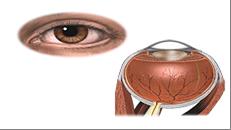Nystagmus
Contents
When to Contact a Medical Professional
What to Expect at Your Office Visit
Nystagmus is a term to describe fast, uncontrollable movements of the eyes that may be:
-
Side to side (horizontal nystagmus)
-
Up and down (vertical nystagmus)
-
Rotary (rotary or torsional nystagmus)
Depending on the cause, these movements may be in both eyes or in just one eye. The term dancing eyes has been used to describe nystagmus.

The cornea allows light to enter the eye. As light passes through the eye the iris changes shape by expanding and letting more light through or constricting and letting less light through to change pupil size. The lens then changes shape to allow the accurate focusing of light on the retina. Light excites photoreceptors that eventually, through a chemical process, transmit nerve signals through the optic nerve to the brain. The brain processes these nerve impulses into sight.
Considerations
The involuntary eye movements of nystagmus are caused by abnormal function in the areas of the brain that control eye movements. The part of the inner ear that senses movement and position (the labyrinth) helps control eye movements.
There are two forms of nystagmus:
- Infantile nystagmus syndrome (INS) is present at birth (congenital).
- Acquired nystagmus develops later in life because of a disease or injury.
Causes
NYSTAGMUS THAT IS PRESENT AT BIRTH (infantile nystagmus syndrome, or INS)
INS is usually mild. It does not become more severe, and it is not related to any other disorder.
People with this condition are usually not aware of the eye movements, but other people may see them. If the movements are large, sharpness of vision (visual acuity) may be less than 20/20. Surgery may improve vision.
Nystagmus may be caused by congenital diseases of the eye. Although this is rare, an ophthalmologist should evaluate any child with nystagmus to check for eye disease.
ACQUIRED NYSTAGMUS
The most common cause of acquired nystagmus is certain drugs or medication. Phenytoin (Dilantin) - an antiseizure medication, excessive alcohol, or any sedating medicine can impair the labyrinth's function.
Other causes include:
- Head injury from motor vehicle accidents
- Inner ear disorders such as labyrinthitis or Meniere's disease
- Stroke
- Thiamine or vitamin B12 deficiency
Any disease of the brain (such as multiple sclerosis or brain tumors) can cause nystagmus if the areas controlling eye movements are damaged.
Home Care
You may need to make changes in the home to help with dizziness, visual problems, or nervous system disorders.
When to Contact a Medical Professional
Call your health care provider if you have symptoms of nystagmus or think you might have this condition.
What to Expect at Your Office Visit
Your health care provider will take a careful history and perform a thorough physical examination, focusing on the nervous system and inner ear. The doctor may ask you to wear a pair of goggles that magnify your eyes for part of the examination.
To check for nystagmus, the health care provider may use the following procedure:
- You spin around for about 30 seconds, stop, and try to stare at an object.
- Your eyes will first move slowly in one direction, then will move quickly in the opposite direction.
If you have nystagmus due to a medical condition, these eye movements will depend on the cause.
Questions asked in a medical history may cover the following areas:
- When were the movements first noticed?
- How often does they occur?
- Has this ever happened before?
- Is the problem getting better, worse, or staying the same?
- Are there side-to-side eye movements?
- Are there up-and-down eye movements?
- What medications are you taking?
- What other symptoms do you have?
You may have the following tests:
- CT scan of the head
- Electro-oculography: An electrical method of measuring eye movements using tiny electrodes
- MRI of the head
- Vestibular testing by recording the movements of the eyes
There is no treatment for most cases of congenital nystagmus. Treatment for acquired nystagmus depends on the cause. In some cases, nystagmus cannot be reversed. In cases due to medications or infection, the nystagmus usually goes away after the cause has gotten better.
Some treatments may help improve the visual function of patients with infantile nystagmus syndrome:
- Prisms
- Surgeries such as tenotomy
- Drug therapies for infantile nystagmus
Alternative Names
Back and forth eye movements; Involuntary eye movements; Rapid eye movements from side to side; Uncontrolled eye movements; Eye movements – uncontrollable

